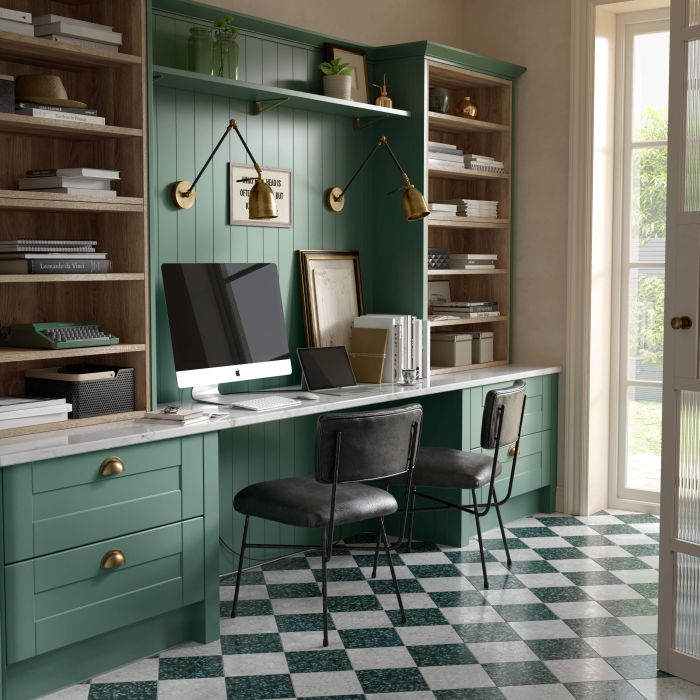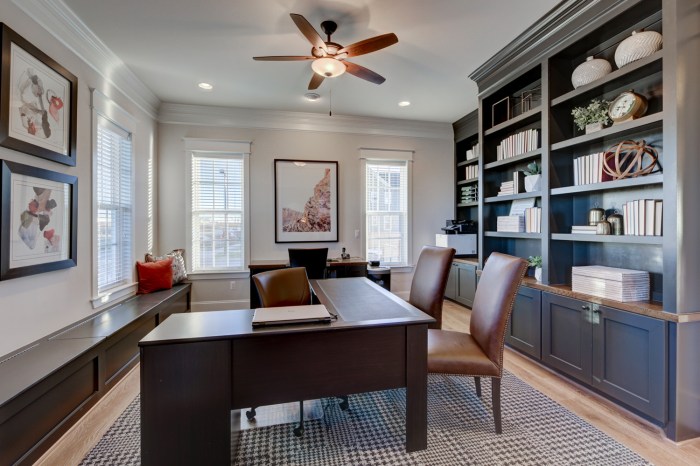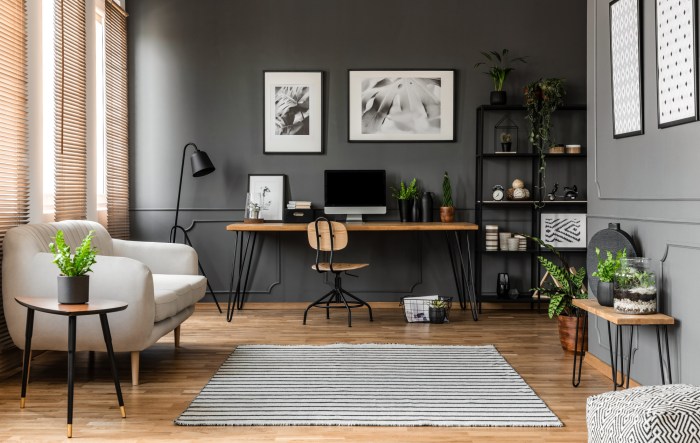Urban Home Design The relentless expansion of urban centers presents a unique challenge: creating comfortable, functional, and aesthetically pleasing homes within often-limited spaces. Urban home design concepts address this challenge head-on, leveraging innovative solutions to maximize functionality, incorporate sustainable practices, and enhance the quality of life within densely populated areas. This exploration delves into the core principles of urban design, examining the interplay of space optimization, technological integration, and eco-conscious materials to craft vibrant and livable urban dwellings.
From minimalist aesthetics to the integration of smart home technology, we’ll investigate how designers are reimagining the urban living experience. We will explore the critical role of natural light and airflow in mitigating the challenges of urban density, while also discussing the importance of incorporating green spaces to foster a connection with nature. This journey will also cover the practical considerations, including zoning regulations and the effective management of space constraints, all underpinned by scientific principles of environmental design and human-centered architecture.
Defining “Urban Home Design Concepts”
Urban home design is a specialized field within architecture and interior design that addresses the unique challenges and opportunities presented by densely populated environments. It goes beyond simply creating aesthetically pleasing spaces; it considers factors like maximizing limited space, integrating with existing infrastructure, and promoting sustainable living within the context of a city. The core principles aim to create functional, comfortable, and visually appealing homes that seamlessly blend into the urban fabric.Urban home design principles prioritize efficiency and functionality.
Space optimization is paramount, often employing clever design solutions to maximize usable area. Natural light and ventilation are strategically incorporated to minimize reliance on artificial lighting and cooling systems, reducing energy consumption and improving indoor air quality. The integration of sustainable materials and technologies, such as green roofs and rainwater harvesting systems, is also a key consideration.
Furthermore, urban designs frequently incorporate smart home technologies to enhance convenience and efficiency.
Urban Design Styles
The diverse nature of urban environments allows for a wide range of design styles, each reflecting different aesthetic preferences and functional needs. Minimalist designs, characterized by clean lines, simple forms, and a focus on essential elements, are popular for their efficiency and ability to create a sense of spaciousness in smaller areas. Industrial-style homes, on the other hand, embrace exposed brick, metal, and concrete, creating a raw and edgy aesthetic.
These styles often incorporate reclaimed materials, reflecting a commitment to sustainability and repurposing. Modern urban homes frequently utilize sleek, contemporary lines, large windows to maximize natural light, and open floor plans to create a sense of flow and spaciousness. These styles often incorporate smart home technologies for added convenience.
Distinguishing Urban from Suburban and Rural Styles
Urban home design differs significantly from suburban and rural styles primarily due to the constraints and opportunities presented by the urban context. Unlike suburban homes, which often feature larger footprints and expansive yards, urban homes are typically smaller and more compact, reflecting the premium placed on land in densely populated areas. The focus shifts from maximizing outdoor space to optimizing indoor functionality and creating a sense of connection with the surrounding urban environment.
Unlike rural homes, which often emphasize a connection with nature and expansive views, urban homes often engage with the city’s vibrant energy and architectural diversity. This may involve incorporating elements that reflect the surrounding urban landscape or maximizing views of city landmarks. The materials used also reflect these differences. Urban homes may incorporate recycled or sustainable materials due to space constraints and environmental concerns, while suburban or rural homes may have greater access to more traditional materials.
Furthermore, the integration of sustainable design principles is more critical in urban settings due to the higher density and potential environmental impact.
Space Optimization in Urban Homes
The relentless growth of urban populations necessitates innovative approaches to residential design. Limited land availability and escalating property prices drive the need for efficient space utilization in urban homes. This requires a paradigm shift from sprawling layouts to cleverly designed, compact spaces that maximize functionality and comfort without compromising on livability. This section explores key strategies for optimizing space in urban apartments, focusing on layout design, storage solutions, and the strategic use of multi-functional furniture.
A Small Urban Apartment Layout Maximizing Functionality
Effective space optimization begins with thoughtful planning of the apartment layout. The following example illustrates a 500 square foot apartment designed for maximum functionality, catering to the needs of a single person or a couple. The design prioritizes open-plan living to create a sense of spaciousness, while strategically positioned partitions and built-in storage maintain privacy and organization.
| Room | Square Footage | Description | Features |
|---|---|---|---|
| Living/Dining Area | 200 | Open-plan space combining living and dining functions. | Large windows for natural light, built-in shelving, foldable dining table. |
| Kitchen | 75 | Compact kitchen with efficient layout. | Space-saving appliances, pull-out drawers, vertical storage. |
| Bedroom | 125 | Includes built-in wardrobe and under-bed storage. | Murphy bed for space saving when not in use. |
| Bathroom | 50 | Compact bathroom with walk-in shower. | Wall-mounted vanity and toilet for maximized floor space. |
| Hallway/Storage | 50 | Includes built-in storage and a small entryway area. | Shelving, coat rack, and shoe storage. |
Innovative Storage Solutions for Compact Urban Living Spaces
Storage is a critical aspect of urban home design. Limited space necessitates creative solutions that maximize storage capacity without compromising aesthetics or functionality. The following strategies are employed in many modern urban apartments:
Several innovative storage solutions exist to address this challenge. Built-in shelving and cabinetry, often custom-designed to fit specific spaces, maximize vertical space and minimize floor clutter. Multi-functional furniture, such as ottomans with built-in storage or beds with drawers underneath, further enhances storage capacity. Vertical storage solutions, including tall, narrow cabinets and wall-mounted shelves, are highly effective in utilizing often-unused vertical space.
Retractable furniture, such as fold-down desks or wall beds, allows for flexible space allocation, providing storage space when the furniture is not in use.
Multi-functional Furniture in Urban Home Design
Multi-functional furniture is a cornerstone of efficient urban living. By combining multiple functions into a single piece, it dramatically reduces the footprint of individual items, increasing overall usable space. Examples include sofa beds that transform from seating to sleeping arrangements, coffee tables with hidden storage compartments, and ottomans that double as additional seating and storage units. The strategic incorporation of multi-functional furniture significantly enhances the functionality and livability of compact urban spaces.
Consider, for example, a Murphy bed that folds away into the wall during the day, freeing up space for a home office or yoga practice. Similarly, a storage bench in an entryway provides seating and storage for shoes and coats, maximizing the limited space of a hallway.
Sustainability and Eco-Friendly Design in Urban Environments
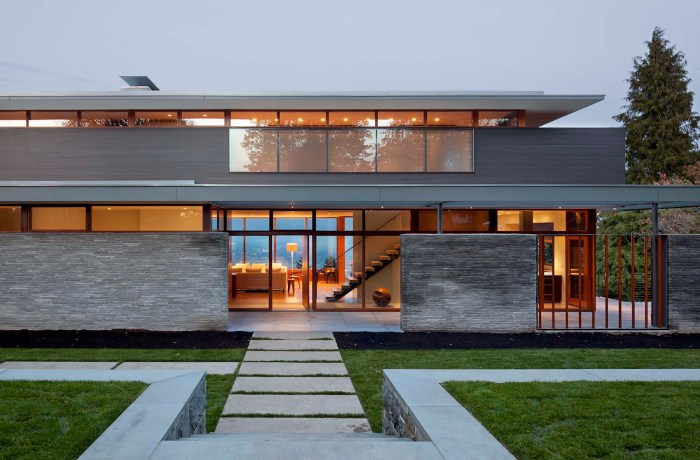
The burgeoning global population and the increasing urbanization trend necessitate a paradigm shift in urban home design. Sustainability is no longer a luxury but a critical component of responsible urban development, demanding innovative approaches to minimize environmental impact while maximizing human comfort and well-being. This involves a holistic approach encompassing material selection, energy efficiency, and landscaping, all working in synergy to create truly eco-conscious urban dwellings.
Integration of Green Building Materials in Urban Homes
The construction industry is a significant contributor to greenhouse gas emissions and resource depletion. Employing green building materials significantly reduces this impact. These materials, sourced responsibly and manufactured with minimal environmental harm, offer superior performance and durability compared to conventional counterparts. For example, using reclaimed wood reduces deforestation and embodies carbon already sequestered in the wood. Bamboo, a rapidly renewable resource, provides a strong and aesthetically pleasing alternative to traditional lumber, requiring less energy for processing.
Similarly, recycled steel and aluminum drastically reduce the energy demands of metal production, while incorporating fly ash (a byproduct of coal combustion) into concrete reduces cement usage and minimizes carbon emissions. The lifecycle assessment of each material, considering its embodied energy and environmental impact from extraction to disposal, is crucial for informed decision-making.
Energy-Efficient Design Strategies for Urban Residences
Minimizing energy consumption in urban homes is paramount for reducing carbon footprints and lowering operational costs. Passive design strategies, which leverage natural elements to regulate temperature and lighting, are highly effective. Properly oriented windows maximize solar gain during winter and minimize heat absorption during summer. Strategically placed overhangs and shading devices prevent direct sunlight from entering during peak heat hours.
High-performance insulation in walls, roofs, and floors significantly reduces heat transfer, minimizing the reliance on heating and cooling systems. The incorporation of smart home technologies further enhances energy efficiency, allowing for automated control of lighting, appliances, and HVAC systems based on occupancy and environmental conditions. For instance, a building management system can optimize energy usage based on real-time data analysis, achieving substantial savings and lowering the environmental burden.
The integration of renewable energy sources, such as solar panels or small-scale wind turbines, further reduces reliance on fossil fuels, generating clean energy on-site. A case study of a residential building in Copenhagen, Denmark, showcased a 70% reduction in energy consumption through the implementation of these strategies.
Sustainable Design Choices for Urban Home Landscaping
Landscaping in urban environments offers significant opportunities for sustainable practices. Careful selection of plant species is critical for minimizing water consumption and promoting biodiversity. Drought-tolerant native plants require less irrigation, reducing water stress and minimizing the need for chemical fertilizers and pesticides. Creating green roofs and walls not only reduces stormwater runoff but also improves insulation and air quality.
The use of permeable paving materials allows rainwater to infiltrate the ground, reducing the burden on urban drainage systems.
- Employ drought-tolerant native plants: These require less watering and maintenance, reducing water consumption and promoting biodiversity.
- Install green roofs and walls: These reduce stormwater runoff, improve insulation, and enhance air quality.
- Use permeable paving materials: Allowing rainwater to infiltrate the ground reduces the load on urban drainage systems and replenishes groundwater.
- Minimize lawn areas: Lawns require significant water and fertilizer, opting for alternative ground covers reduces these demands.
- Incorporate rainwater harvesting systems: Collected rainwater can be used for irrigation, reducing reliance on municipal water supplies.
Light and Airflow in Urban Homes
Urban home design presents a unique challenge: maximizing natural light and ventilation while minimizing the intrusion of noise and pollution inherent in densely populated areas. Effective design strategies are crucial for creating healthy, comfortable, and energy-efficient living spaces within the constraints of the urban environment. The interplay of light, airflow, and noise control significantly impacts the quality of life within an urban dwelling.
Optimizing light and airflow in urban homes requires a multi-pronged approach, integrating passive design strategies with carefully selected materials and technologies. The orientation of the building, the placement of windows, and the design of internal spaces all contribute to the effectiveness of natural ventilation and daylighting. Furthermore, the mitigation of noise pollution is a critical aspect of creating a peaceful and restorative living space.
Maximizing Natural Light and Ventilation in Densely Populated Areas
Effective floor plans in dense urban areas prioritize maximizing natural light and ventilation through strategic window placement and internal spatial arrangements. For instance, a south-facing orientation (in the Northern Hemisphere) allows for maximum solar gain during winter, while strategically placed overhangs or awnings prevent overheating during summer. In a multi-story building, courtyards or atria can be incorporated to introduce natural light and air circulation into the interior spaces.
Windows should be strategically positioned to create cross-ventilation, allowing for a natural airflow that reduces the reliance on mechanical ventilation systems. The use of operable windows, strategically placed to catch prevailing breezes, is essential. A typical example would be a three-story building where ground floor windows face east to catch morning sun, while upper floor windows face west to catch afternoon breezes, ensuring cross-ventilation throughout the day.
Furthermore, the use of light-colored, reflective materials both internally and externally can increase light reflectance and reduce heat absorption, improving energy efficiency.
Strategies for Mitigating Noise Pollution in Urban Homes
Noise pollution significantly impacts the quality of life in urban environments. Effective strategies for mitigating noise within a home include the use of sound-insulating materials in the building envelope, such as double- or triple-glazed windows, and sound-absorbing materials within the interior spaces. The strategic placement of rooms – for example, locating bedrooms away from busy streets – can minimize noise intrusion.
Landscaping, such as strategically placed trees and shrubs, can act as natural sound barriers, reducing the transmission of noise from external sources. The use of green walls or roof gardens can further enhance noise reduction and improve the overall acoustic environment. For example, a building located near a busy highway might incorporate a green wall on the facade facing the highway, reducing traffic noise by up to 10 decibels, according to studies conducted by the University of Salford.
This reduction can translate to a noticeable decrease in perceived loudness.
Incorporating Green Spaces into Urban Home Designs
The incorporation of green spaces into urban home designs offers numerous benefits, extending beyond aesthetic appeal. Green roofs, vertical gardens, and even small balconies with potted plants can significantly improve air quality, reduce the urban heat island effect, and provide a connection to nature within the confines of the urban environment. Green spaces also contribute to biodiversity and can support local ecosystems.
Studies have shown that access to green spaces reduces stress and improves mental well-being. For example, a study published in the journal “Environment and Behavior” found that residents living in buildings with green roofs reported lower levels of stress and improved psychological well-being compared to those living in buildings without green roofs. Furthermore, the inclusion of green spaces can increase property values, reflecting the growing demand for sustainable and eco-friendly urban living.
Technological Integration in Urban Home Design
The relentless march of technology has profoundly reshaped the urban landscape, and nowhere is this more evident than in the design of modern homes. Smart home technology is no longer a luxury; it’s becoming a necessity, enhancing not only convenience but also safety, energy efficiency, and overall quality of life for urban dwellers facing space constraints and demanding lifestyles.
This integration seamlessly blends functionality with aesthetics, creating living spaces that are both intelligent and inviting.Smart home technology plays a crucial role in optimizing urban living by addressing the unique challenges of dense populations and limited resources. By automating various aspects of home management, these systems free up valuable time and energy, allowing residents to focus on other priorities.
Furthermore, the data-driven insights provided by smart home devices enable proactive adjustments to energy consumption, security protocols, and even environmental controls, ultimately contributing to a more sustainable and efficient urban environment. This integration is not merely about convenience; it’s about enhancing the overall livability of urban spaces.
Automation Systems in Urban Home Design
Automation systems form the backbone of smart home technology, enabling centralized control and coordination of various devices and appliances. These systems often rely on a central hub, such as a smart speaker or a dedicated home automation controller, which communicates with individual devices via various protocols like Wi-Fi, Zigbee, or Z-Wave. This allows for seamless integration of lighting, climate control, security systems, entertainment, and even appliances, all managed through a single interface – a smartphone app, a touchscreen panel, or voice commands.
For instance, a resident could program the system to adjust the lighting and temperature based on the time of day, automatically lock doors when leaving home, or receive alerts if a sensor detects a leak. The sophistication of these systems varies greatly, from basic timers to complex AI-driven solutions capable of learning user preferences and adapting accordingly. The level of automation is tailored to individual needs and budget, making it accessible across a wide range of urban homes.
Beneficial Smart Home Devices for Urban Spaces
The benefits of smart home technology are particularly pronounced in urban environments where space is at a premium. The following list highlights some of the most beneficial smart home devices for urban dwellers:
- Smart Lighting: LED smart bulbs offer energy efficiency and customizable lighting scenes, optimizing light levels throughout the day and creating different moods. They can be scheduled to turn on and off automatically, mimicking occupancy and saving energy. Dimmable options further enhance energy conservation and mood setting.
- Smart Thermostats: These devices learn user preferences and adjust temperatures accordingly, optimizing energy consumption and promoting comfort. Geofencing capabilities allow the thermostat to automatically adjust based on the residents’ location, ensuring the home is not heated or cooled unnecessarily when unoccupied. This feature is particularly beneficial in reducing energy waste in urban apartments.
- Smart Security Systems: Including features like smart locks, security cameras, and motion detectors, these systems enhance safety and peace of mind, especially crucial in densely populated areas. Remote monitoring capabilities allow residents to check on their home from anywhere, adding an extra layer of security. Real-time alerts and video recordings provide valuable evidence in case of incidents.
- Smart Appliances: Smart refrigerators can track food inventory, suggesting recipes and alerting users to expiring items. Smart washing machines and dryers offer remote control and optimized wash cycles, saving water and energy. These appliances contribute to efficient resource management in urban living.
- Smart Speakers: These devices serve as central control hubs for many smart home systems, allowing voice control of lighting, temperature, music, and other functions. Their hands-free operation is especially convenient in busy urban lifestyles.
Urban Home Design Aesthetics and Trends
Urban home design aesthetics are in constant flux, reflecting broader societal shifts, technological advancements, and evolving cultural preferences. Understanding these trends is crucial for both designers and homeowners seeking to create functional and visually appealing living spaces within the constraints of urban environments. The interplay between functionality, sustainability, and aesthetic appeal is paramount in shaping the modern urban home.
Current trends reveal a move towards minimalist designs, emphasizing clean lines, open floor plans, and a focus on natural light and materials. However, this minimalism is often juxtaposed with elements of maximalism, introducing pops of color, texture, and personality through carefully curated artwork, furniture, and accessories. Sustainability remains a key driver, with a growing demand for eco-friendly materials and energy-efficient designs.
Furthermore, technological integration is seamlessly woven into the fabric of these spaces, enhancing convenience and improving quality of life.
Current Urban Design Styles
The following table compares and contrasts three prominent urban design styles: Minimalist, Industrial, and Scandinavian. These styles, while distinct, often share common threads such as a focus on functionality and the incorporation of natural light.
| Style | Key Features | Color Palette & Materials |
|---|---|---|
| Minimalist | Clean lines, open floor plans, multifunctional furniture, neutral color palettes, emphasis on natural light. | Whites, grays, blacks; natural wood, concrete, glass, steel. |
| Industrial | Exposed brick, metal accents, high ceilings, reclaimed wood, vintage furniture, raw textures. | Grays, browns, blacks; metal, wood, brick, concrete. |
| Scandinavian | Light and airy spaces, natural materials, simple lines, functional furniture, emphasis on hygge (coziness). | Whites, creams, pastels; natural wood, wool, linen, leather. |
Modern Urban Home Interior Visualization
Imagine a modern urban apartment, approximately 70 square meters. The open-plan living area is bathed in natural light streaming through large, energy-efficient windows. The color palette is predominantly neutral, featuring warm whites on the walls, contrasted by the cool gray tones of polished concrete flooring. A feature wall, showcasing reclaimed wood planks with a subtly textured finish, adds visual interest and warmth.The living room is furnished with a modular sofa in a light gray fabric, complemented by a low-slung coffee table made from sustainably sourced oak.
A large, minimalist rug in a natural jute fiber defines the seating area. Subtle pops of color are introduced through carefully chosen accessories – a vibrant throw pillow, a ceramic vase with dried flowers, and a framed piece of abstract art. The kitchen, seamlessly integrated into the open-plan design, features sleek, minimalist cabinetry in matte white, paired with stainless steel appliances.
The countertops are made of a durable, sustainable composite material, reflecting the commitment to environmentally conscious design choices. The overall effect is one of understated elegance, blending functionality with a sense of calm and sophistication. The textures, from the smooth concrete to the rough-hewn wood, create a tactile experience that adds depth and character to the space.
Challenges and Considerations in Urban Home Design
Designing homes within the confines of densely populated urban areas presents a unique set of challenges that extend beyond the typical considerations of suburban or rural construction. The interplay of limited space, stringent regulations, and the need for sustainable practices necessitates innovative and often unconventional approaches to home design. These challenges, however, also foster creativity and push the boundaries of architectural ingenuity, leading to highly efficient and aesthetically pleasing living spaces.
Zoning Regulations and Their Impact on Urban Home Design
Zoning regulations, implemented by local governments to control land use and development, significantly influence the design and construction of urban homes. These regulations often dictate building height restrictions, setbacks from property lines, allowable floor area ratios (FAR), and parking requirements. For example, a strict FAR limit might prevent the construction of a larger, more spacious home on a small lot, forcing designers to prioritize vertical space and maximize efficiency.
Similarly, mandatory setbacks can reduce the usable building footprint, demanding creative solutions to optimize interior space. The impact of these regulations varies greatly depending on the specific location and the goals of the zoning ordinances, with some promoting density and others prioritizing open space. In areas with strict height restrictions, for instance, architects might employ innovative design elements like atriums or skylights to maximize natural light and create a sense of spaciousness.
Overcoming Space Constraints in Urban Home Design
Space optimization is paramount in urban home design. The limited availability of land necessitates strategies that maximize functionality within a smaller footprint. This often involves incorporating multi-functional furniture, such as sofa beds or wall beds, that can serve multiple purposes. Clever storage solutions, including built-in cabinetry and under-stair storage, are crucial for minimizing clutter and maximizing usable space.
Vertical space is often utilized extensively, with loft bedrooms or mezzanine levels becoming common features in urban homes. Furthermore, the integration of technology, such as smart home systems, can enhance space efficiency by automating tasks and optimizing resource utilization. For example, a smart thermostat can automatically adjust temperature based on occupancy, reducing energy consumption and improving comfort.
The use of modular furniture allows for flexibility and adaptability, allowing homeowners to reconfigure their spaces as their needs change.
Challenges of Designing for Density and Infrastructure
The high density of urban areas presents challenges related to infrastructure and accessibility. Limited access to natural light and ventilation necessitates careful planning and the incorporation of passive design strategies, such as strategically placed windows and courtyards, to mitigate these issues. The proximity of neighboring buildings can also impact privacy, requiring creative design solutions, such as the use of strategically placed landscaping or soundproofing materials.
Furthermore, the existing infrastructure, including water, sewer, and electricity grids, may present constraints on building design and necessitate careful consideration of the load capacity and availability of resources. In some instances, innovative solutions, such as greywater recycling systems, may be required to mitigate the strain on existing infrastructure. Designing for accessibility, including compliance with ADA standards for people with disabilities, is also a significant challenge in densely populated areas, requiring thoughtful consideration of building codes and universal design principles.
Case Studies of Successful Urban Home Designs
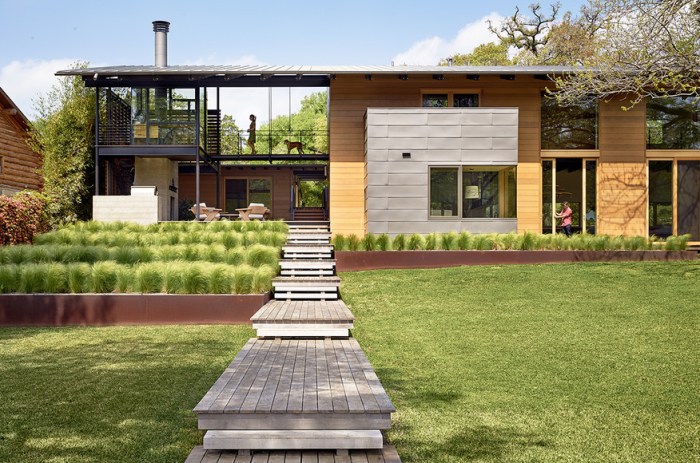
The following case studies illustrate how innovative design principles can overcome the challenges of urban living, creating comfortable, sustainable, and aesthetically pleasing homes. These projects demonstrate the successful integration of space optimization, sustainable materials, and technological advancements within the constraints of urban environments. Each example showcases a unique approach to addressing the specific demands of its location and the needs of its inhabitants.
The Courtyard House in Barcelona
This project, located in a densely populated area of Barcelona, cleverly utilizes a central courtyard to maximize natural light and ventilation.
The Barcelona courtyard house exemplifies how a thoughtful design can transform a limited footprint into a spacious and vibrant living space. The central courtyard acts as a green lung, mitigating the urban heat island effect and providing a tranquil oasis within the bustling city. The design incorporates passive solar strategies, with south-facing windows maximizing solar gain during winter and shading mechanisms protecting the interior from excessive summer heat.
Materials used, such as locally sourced stone and recycled wood, further enhance the sustainability of the project. The layout prioritizes open-plan living spaces, visually expanding the interior and blurring the lines between indoor and outdoor environments. The design also cleverly integrates water-saving technologies, such as rainwater harvesting systems and low-flow fixtures. The result is a home that feels significantly larger than its actual square footage, offering a high quality of life within a compact urban setting.
The Stacked Apartment in Tokyo
This high-rise apartment building in Tokyo demonstrates the effective use of vertical space and modular design to create efficient and comfortable living units.
The Tokyo stacked apartment project showcases the potential of vertical living in high-density urban areas. The design utilizes a modular construction approach, allowing for rapid and cost-effective construction. Each apartment unit is carefully planned to maximize space efficiency, with built-in storage solutions and multi-functional furniture. Natural light is maximized through the strategic placement of windows and skylights, mitigating the common problem of limited natural light in high-rise buildings.
The building also incorporates sustainable features, including energy-efficient appliances and a green roof to reduce the urban heat island effect and improve air quality. The integration of communal spaces, such as rooftop gardens and shared workspaces, fosters a sense of community among residents. This design effectively addresses the challenges of limited land availability and high population density, creating a comfortable and sustainable living environment.
The Adaptive Reuse Project in Amsterdam
This project demonstrates the transformation of a former industrial building into a contemporary urban home, showcasing the potential of adaptive reuse in urban regeneration.
The Amsterdam adaptive reuse project exemplifies how existing structures can be repurposed to create unique and sustainable urban homes. The conversion of a former industrial warehouse into a residential space showcases a commitment to sustainability through the preservation of existing materials and structures. The original building’s high ceilings and large windows were retained, creating a sense of spaciousness and allowing for ample natural light.
Industrial aesthetics were incorporated into the design, creating a unique and stylish living space. Sustainable materials and technologies were integrated into the renovation process, minimizing the environmental impact of the project. The result is a home that seamlessly blends historical character with modern comfort, contributing to the preservation of the city’s architectural heritage while offering a sustainable and aesthetically pleasing living environment.
The project demonstrates the potential of adaptive reuse in creating unique and sustainable urban homes, contributing to the preservation of architectural heritage and minimizing the environmental impact of new construction.
Ultimately, successful urban home design hinges on a holistic approach that considers not only the physical constraints of the urban environment but also the needs and aspirations of its inhabitants. By integrating sustainable practices, embracing technological advancements, and prioritizing human well-being, we can create urban homes that are not merely functional shelters, but vibrant and enriching spaces that foster a high quality of life.
The future of urban living rests on our ability to creatively adapt to density while maintaining a connection to nature and a commitment to environmental responsibility – a future built on the innovative principles explored within these urban home design concepts.
Detailed FAQs
What are the most common building materials used in sustainable urban home design?
Sustainable urban home design frequently utilizes materials like reclaimed wood, bamboo, recycled steel, and low-VOC paints. These materials minimize environmental impact and improve indoor air quality.
How can I maximize natural light in a small urban apartment?
Maximize natural light by using light-colored paints, strategically placing mirrors to reflect light, and opting for sheer curtains that allow light to filter through while maintaining privacy. Consider skylights if structurally feasible.
What are the benefits of incorporating green spaces into urban home design?
Green spaces in urban homes improve air quality, reduce noise pollution, provide opportunities for relaxation and stress reduction, and can even increase property value. They also contribute to a healthier urban ecosystem.
How can smart home technology improve urban living?
Smart home technology can optimize energy consumption, enhance security, improve comfort through automated climate control, and provide convenient remote access to home systems, all contributing to a more efficient and enjoyable urban living experience.
What are the challenges of designing for diverse urban populations?
Designing for diverse populations requires understanding varying needs and preferences related to accessibility, cultural sensitivities, and economic considerations. Universal design principles are crucial to creating inclusive spaces.
Read More: Kanavino.org
